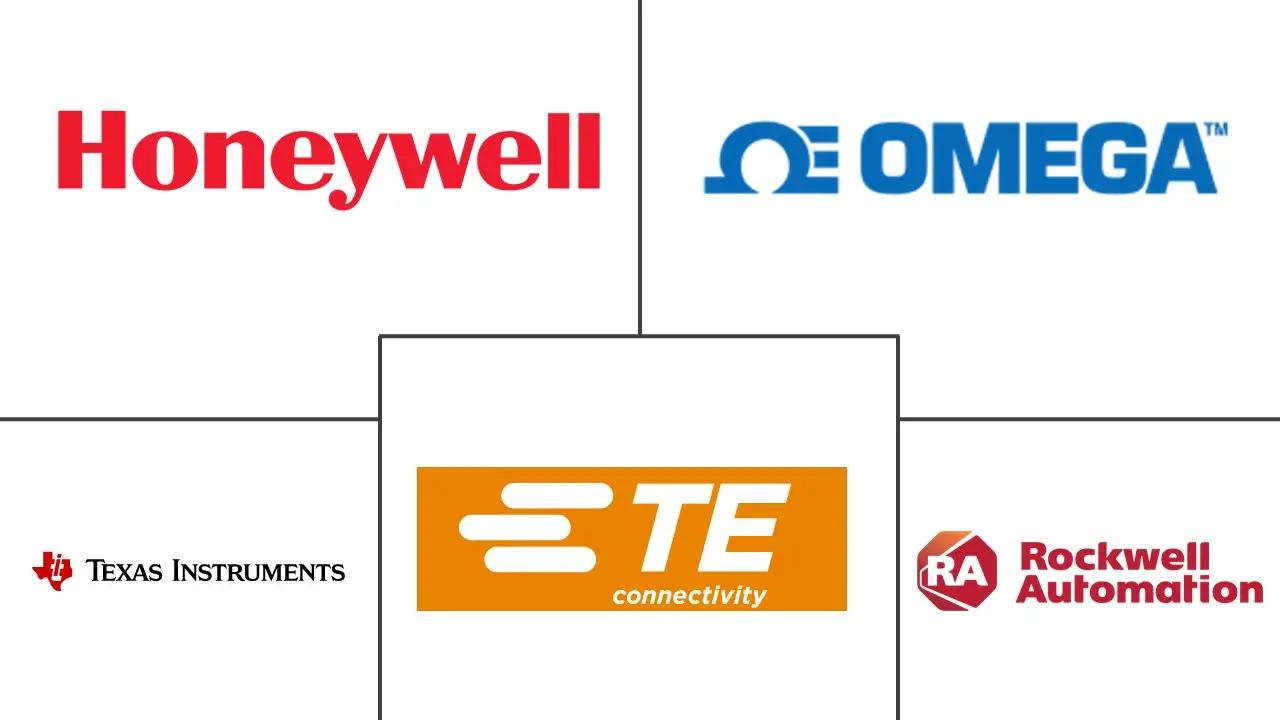Sensors Market Size and Share
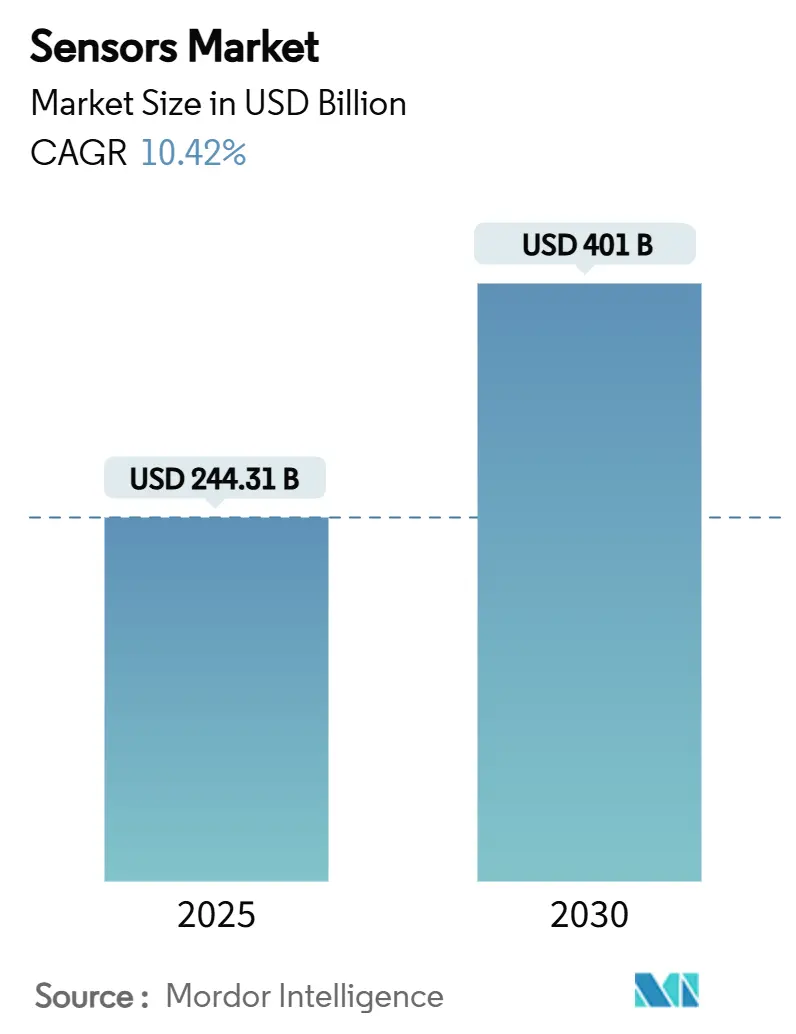
Sensors Market Analysis by Mordor Intelligence
The sensors market size reached USD 244.31 billion in 2025 and is forecast to climb to USD 401 billion by 2030, advancing at a 10.42% CAGR. The growth is propelled by wider adoption of autonomous mobility platforms, rapid industrial automation, and expanding use-cases in connected healthcare. Convergence between artificial intelligence and sensor hardware is enabling predictive maintenance systems that cut unplanned factory downtime by up to 50%. Temperature devices currently dominate the sensors market with 23% share, while chemical variants are on track for the fastest expansion at a 14.8% CAGR. Asia-Pacific leads demand on the back of Chinese smart manufacturing programs, strong automotive innovation in Japan, and long-standing semiconductor supply chains. At the same time, Middle East & Africa is emerging as the quickest-growing region, supported by large-scale infrastructure digitalization and clean-energy buildouts. Competitive intensity remains high and fragmented, yet recent joint ventures and targeted acquisitions are accelerating consolidation around multimodal and AI-enabled product portfolios.[1]Bosch Press, “AI-enabled sensors deliver life-changing use cases,” us.bosch-press.com
Key Report Takeaways
- By parameter measured, temperature devices led with 23% sensors market share in 2024; chemical sensors are set to rise at 14.8% CAGR to 2030.
- By technology, MEMS accounted for 40.7% of the sensors market size in 2024, while quantum-tunneling composite devices are projected to surge at 17.65% CAGR over the same period.
- By end-user industry, automotive retained 24.9% sensors market share in 2024; medical and wellness applications are forecast to grow the fastest at 12.4% CAGR through 2030.
- By geography, Asia-Pacific captured 36.56% revenue share in 2024; Middle East & Africa is expected to register a 15.21% CAGR to 2030.
- Bosch, STMicroelectronics, and Texas Instruments together supplied about 30% of global unit shipments in 2024.
Global Sensors Market Trends and Insights
Drivers Impact Analysis
| Driver | (~) % Impact on CAGR Forecast | Geographic Relevance | Impact Timeline |
|---|---|---|---|
| Increasing adoption of multi-sensor fusion in autonomous mobility | 2.80% | North America, Europe, Asia-Pacific | Medium term (2-4 years) |
| Proliferation of smart-factory retrofits in brown-field Asian plants | 2.10% | Asia-Pacific, Emerging markets | Short term (≤ 2 years) |
| Shift toward condition-based asset monitoring in offshore energy | 1.40% | Global offshore basins | Long term (≥ 4 years) |
| Mandatory inclusion of ADAS sensing suites in next-gen EU vehicles | 1.90% | Europe, Global OEM supply chains | Medium term (2-4 years) |
| Ultra-low-power environmental sensing for battery-free IoT tags | 1.20% | Developed markets | Long term (≥ 4 years) |
| Expansion of renewable-energy monitoring requirements (solar & wind) | 1.50% | Middle East & Africa, Europe, Asia-Pacific | Medium term (2-4 years) |
| Source: Mordor Intelligence | |||
Increasing adoption of multi-sensor fusion in autonomous mobility
LiDAR, radar, and camera streams are now integrated into unified perception stacks, creating redundancy that meets the EU General Safety Regulation 2019/2144 for advanced driver assistance in all new vehicles. Tesla’s full self-driving computer already processes inputs from 8 cameras, 12 ultrasonic units, and a radar at 144 TOPS, setting a performance benchmark. Tier-1 suppliers are responding with pre-calibrated perception suites that lower integration cost, compress bill-of-materials, and accelerate time-to-market. [2]Tesla, “Vehicle Autopilot Hardware,” tesla.com
Proliferation of smart-factory retrofits in brown-field Asian plants
China’s 14th Five-Year Plan earmarked USD 1.4 trillion for digital infrastructure, much of which targets sensor-rich upgrades of legacy machinery to unlock predictive maintenance and 20-30% lifecycle extensions. Vibration, temperature, and flow devices fitted to existing lines feed cloud analytics that cut downtime and lift overall equipment effectiveness without full plant reconstruction.
Shift toward condition-based asset monitoring in offshore energy
North Sea operators report that unscheduled production halts can cost USD 1–5 million per day, giving high payback on robust vibration and pressure sensor arrays able to detect bearing wear up to a year before failure. Satellite backhaul now streams data from remote platforms to onshore centers in real time, supporting model-based predictive maintenance that enhances safety and cuts intervention costs.
Mandatory inclusion of ADAS sensing suites in next-gen EU vehicles
EU regulations require automatic emergency braking, lane departure alerts, and driver monitoring on every new model by 2026. This rule establishes a floor of vision, radar, and ultrasonic hardware per vehicle, scaling the sensors market far beyond premium segments. Bosch integrates AI co-processors inside its latest MEMS devices to shrink system footprints while complying with functional-safety norms.
Restraints Impact Analysis
| Restraint | (~) % Impact on CAGR Forecast | Geographic Relevance | Impact Timeline |
|---|---|---|---|
| Supply tightness of automotive-grade MEMS foundry capacity | -1.80% | Asia-Pacific, Europe | Short term (≤ 2 years) |
| Calibration drift challenges in long-life vibration sensors | -0.90% | Industrial, Aerospace | Medium term (2-4 years) |
| Fragmented wireless protocol standards hindering smart-sensor interoperability | -1.10% | IoT, Industrial automation | Long term (≥ 4 years) |
| Rising cybersecurity concerns across connected sensor networks | -1.00% | Global | Medium term (2-4 years) |
| Source: Mordor Intelligence | |||
Supply tightness of automotive-grade MEMS foundry capacity
AEC-Q100 qualification cycles span up to two years and only a few Asia-Pacific fabs meet the stringent criteria. STMicroelectronics is expanding clean-room footprints, yet EV proliferation adds pressure by introducing fresh battery-management and thermal-monitoring loads.
Calibration drift challenges in long-life vibration sensors
Units deployed on offshore wind turbines and oil platforms must remain accurate for 10–20 years without human access. Drift from thermal cycling and mechanical stress triggers false alarms or missed failures. Quantum-tunnelling composite designs promise higher stability but are still in early commercialization stages.
Segment Analysis
By Parameter Measured: Temperature dominance drives thermal innovation
Temperature devices held 23% sensors market share in 2024 and remain indispensable for automotive thermal loops and industrial process control. Chemical variants are scaling fastest, on course for 14.8% CAGR through 2030 on rising emissions monitoring and workplace-safety mandates. Flow, vibration, and pressure categories together deepen the sensors market with predictive maintenance reach, while proximity units ensure machine-guarding compliance.
Continued miniaturization now allows integrated AI engines inside temperature elements, enabling local anomaly detection without cloud latency. Inertial, magnetic, optical, and humidity devices round out the portfolio, serving everything from smartphone orientation to smart-city air-quality grids.
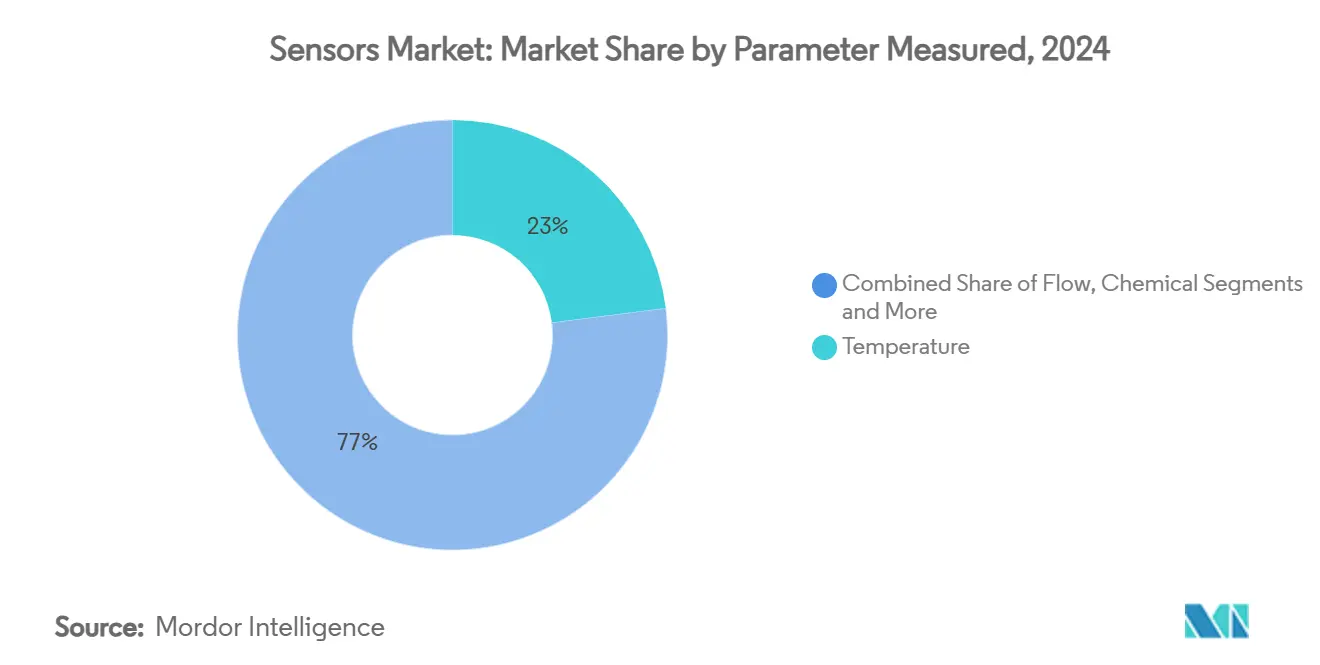
Note: Segment shares of all individual segments available upon report purchase
By Mode of Operation: Electrical-resistance leadership as LiDAR accelerates
Electrical-resistance designs accounted for 19.4% of the sensors market in 2024 thanks to low cost and broad design-in across industrial and vehicle dashboards. LiDAR systems, critical for autonomous navigation, are projected to rise at 17.3% CAGR through 2030, reflecting price drops and movement to solid-state arrays that shed mechanical parts. Optical, piezoresistive, piezoelectric, capacitive, magnetic, and acoustic modes complete a diverse field addressing vision, pressure, vibration, touch, and sound requirements.
Advances such as Velodyne’s 4D LiDAR integrate velocity vectors with distance and angle, sharpening object classification for driver-assist functions. Meanwhile, piezoelectric harvesters supply micro-joule power budgets for battery-less sensor nodes in remote pipelines. [3]Velodyne Lidar, “Introducing Velarray H800 4D Lidar,” velodynelidar.com
By Technology: MEMS leadership faces quantum-tunnelling disruption
MEMS devices controlled 40.7% of the sensors market size in 2024, benefitting from three decades of yield improvement and automotive qualification. Quantum-tunnelling composite alternatives are forecast to grow 17.65% annually, offering heightened sensitivity and drift-free stability. Photonic, CMOS, and emerging NEMS formats add bandwidth and integration options for machine-vision, optical comms, and biochemical detection.
Quantum-tunnelling pressure cells, exploiting electron tunnelling across polymer matrices, outperform MEMS at wide temperature swings, a key requirement in aerospace cabins and downhole energy gears. CMOS image arrays integrate on-die digital processing for AI vision tasks at the edge.
By End-User Industry: Automotive dominance meets medical innovation
Automotive applications contributed 24.9% revenue in 2024, lifted by ADAS, EV battery management, and tighter emissions rules. Healthcare is advancing fastest at 12.4% CAGR, driven by continuous glucose monitors, wearables, and hospital tele-monitoring. Industrial manufacturing keeps strong demand for vibration, temperature, and flow sensors that enable predictive maintenance, while aerospace, consumer electronics, energy, construction, and defense each supply distinct pockets of opportunity.
Clinical trials now validate needle-free continuous glucose systems at accuracy levels equivalent to finger-stick controls, highlighting how biocompatible devices extend the sensors market into long-term patient-care settings.
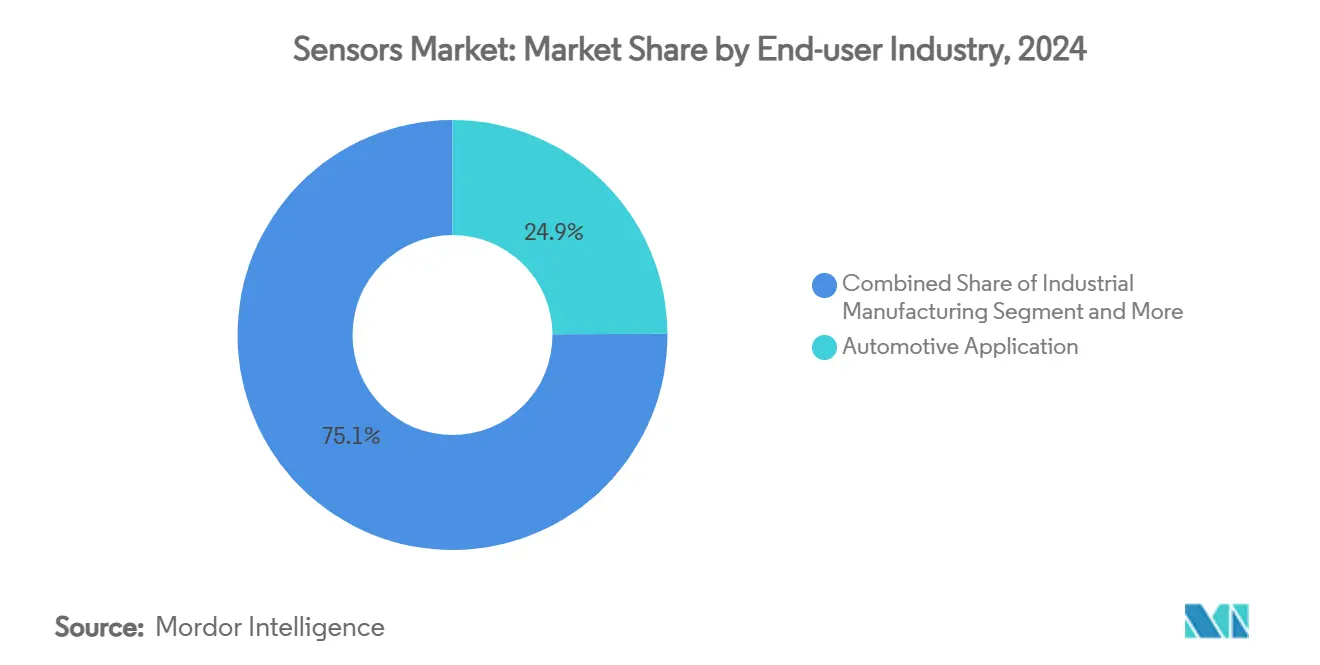
Note: Segment shares of all individual segments available upon report purchase
By Output: Digital transformation enables smart connectivity
Analog outputs remain useful for real-time control loops demanding microsecond response and deterministic behaviour. Digital variants, however, enjoy rising penetration as they simplify calibration, cut noise, and plug straight into MCU buses like I²C, SPI, or CAN. Embedded edge intelligence adds encryption and secure boot features essential for authenticated industrial networks.
Dual-mode devices providing simultaneous analogy and digital streams cater to mixed legacy-plus-cloud environments. Growth in digital outputs aligns with the broader Industry 4.0 shift, further enlarging the sensors market.
Geography Analysis
Asia-Pacific held 36.56% of global revenue in 2024, anchored by China’s USD 1.4 trillion digital-infrastructure push, Japan’s advanced automotive supply chains, and South Korea’s lithography leadership. Government incentives lower capital hurdles for fabs and embedded-sensor startups alike, translating into a dense regional cluster of design and production know-how. Suppliers enjoy proximity to the bulk of consumer-electronics assembly lines, compressing lead times and logistics costs.
Europe delivers steady high-value demand around stringent safety and environmental regulations. Mandatory ADAS fitment and industrial decarbonization targets push purchasing toward higher-performance, functionally safe products. The EU’s Chips Act grants and European Investment Bank loans such as NXP’s EUR 1 billion facilities funnel fresh capacity into on-shore automotive-grade production.
Middle East & Africa is projected to expand at 15.21% CAGR as Gulf Cooperation Council states embed smart grids, desalination monitoring, and large-scale renewables. African mining and transport corridors increasingly deploy ruggedized sensors that tolerate dust, vibration, and power instability. Latin America, though smaller, sees smart-agriculture pilots across Brazil and Mexico, adding incremental volume.
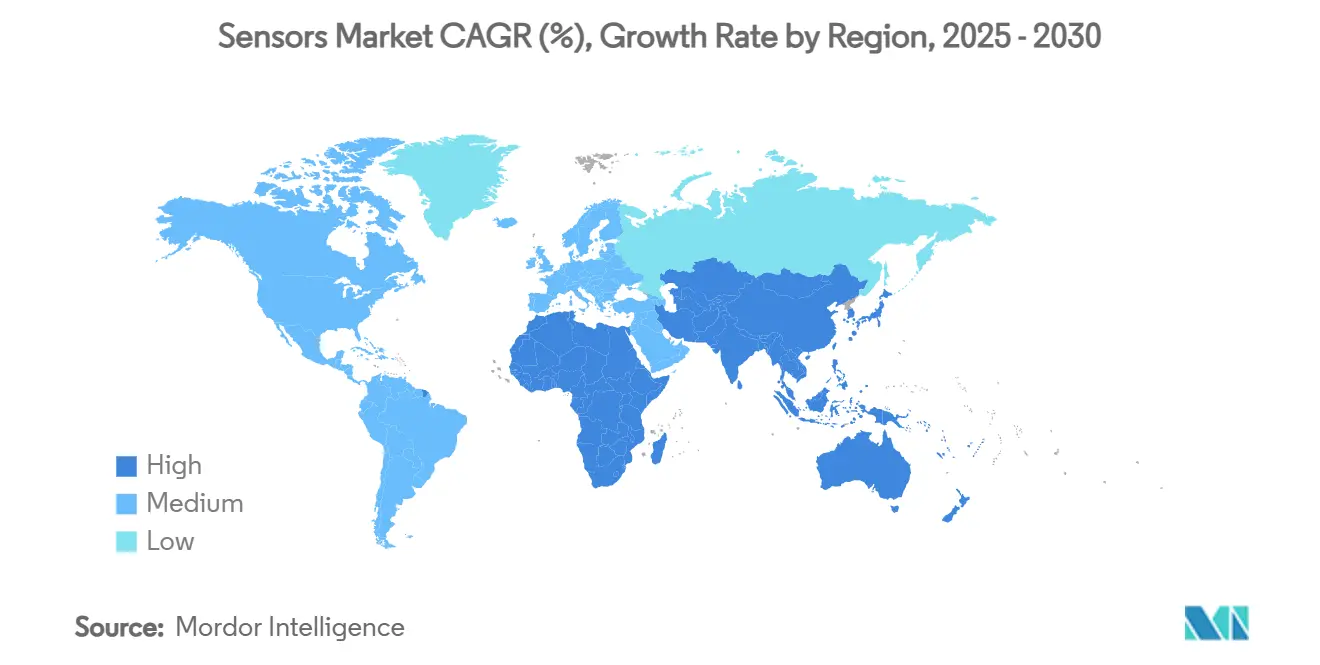
Competitive Landscape
The market hosts a blend of diversified semiconductor majors and agile specialists. Bosch Sensortec, STMicroelectronics, Texas Instruments, and NXP command scale advantages in wafer supply, R&D budgets, and automotive qualification. Specialists such as SICK, Endress+Hauser, and Velodyne focus on lane-leader niches in industrial flow, gas analysis, and LiDAR.
Strategic collaboration is rising. In March 2025, SICK spun its gas-analysis unit into a 50-50 joint venture with Endress+Hauser, pooling 800 staff across 42 countries to accelerate decarbonization instrumentation. Acquisition activity also intensifies: Syntiant purchased Knowles’ consumer MEMS microphone line for USD 150 million to bundle always-on audio front ends with local AI inference. Capacity-driven deals, such as Viavi’s USD 150 million acquisition of Inertial Labs, widen domain exposure to aerospace and defense.
Quantum-tunnelling composite innovators seek design-ins with OEMs frustrated by MEMS drift. Likewise, ultra-low-power wireless SOC vendors court battery-free IoT deployments that mainstream chip houses have yet to prioritize. Pricing power varies commodity temperature parts face razor margins, whereas integrated AI sensor nodes command premium ASPs thanks to system-level savings on compute boards and cabling. [4]Endress+Hauser, “Strategic partnership launched,” endress.com
Sensors Industry Leaders
-
Honeywell International Inc.
-
Texas Instruments Inc.
-
Rockwell Automation Inc.
-
TE Connectivity Ltd
-
OMEGA Engineering inc.
- *Disclaimer: Major Players sorted in no particular order
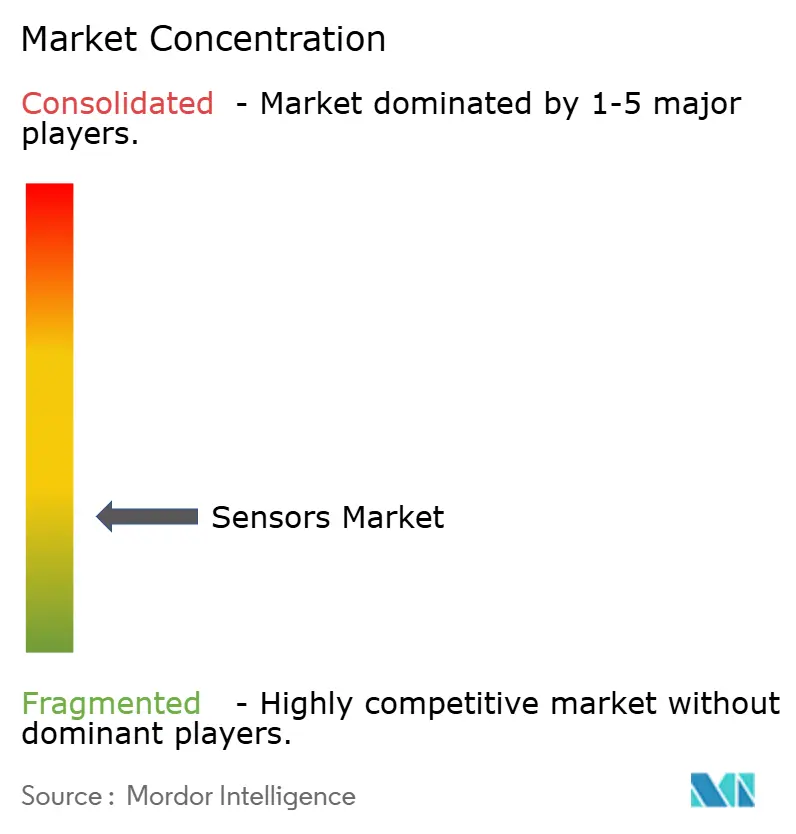
Recent Industry Developments
- March 2025: SICK and Endress+Hauser finalized Endress+Hauser SICK GmbH+Co. KG to advance gas-analysis and flow technology.
- January 2025: NXP Semiconductors secured a EUR 1 billion loan from the European Investment Bank for automotive sensor innovation.
- January 2025: Bosch set a target to deliver 10 billion deeply integrated MEMS units by 2030, having exceeded 1 billion in 2024.
- December 2024: Viavi Solutions announced plans to acquire Inertial Labs for USD 150 million plus earn-outs over four years.
Global Sensors Market Report Scope
A sensor detects and responds to inputs from the physical environment. A typical input could be pressure, light, heat, motion, or moisture, among many others. There is a significant increase in the trend toward automation. As sensors play the most important role in every aspect of automation, the global sensor market is expected to witness high growth during the forecast period.
The global sensor market report is segmented by parameters measured (temperature, pressure, level, flow, proximity, environmental, chemical, inertial, magnetic, vibration, and other parameters measured), by mode of operation (optical, electrical resistance, biosensor, piezoresistive, image, capacitive, piezoelectric, liDAR, radar, and other modes of operation), by end-user industry (automotive, consumer electronics (smartphones, tablets, laptops, and computers, wearable devices, smart appliances or devices, and other consumer electronics)), by energy, industrial, medical and wellness, construction, agriculture, and mining, aerospace, and defense), and geography( North America, Europe, Asia-Pacific, Latin America and Middle East and Africa). The market sizes and forecasts are provided in terms of value (USD) for all the above segments.
| Temperature |
| Flow |
| Chemical |
| Vibration |
| Pressure |
| Proximity |
| Inertial |
| Other Parameters |
| Optical |
| Piezoresistive |
| Piezoelectric |
| Electrical Resistance |
| Image |
| LiDAR |
| Other Modes |
| MEMS |
| Photonic |
| CMOS |
| Nano-electromechanical (NEMS) |
| Discrete Sensors |
| Integrated / Embedded Sensors |
| Analog |
| Digital |
| Automotive |
| Industrial Manufacturing |
| Medical and Wellness |
| Aerospace |
| Consumer Electronics |
| Oil and Gas |
| Construction |
| Defense |
| North America | United States |
| Canada | |
| Mexico | |
| Europe | United Kingdom |
| Germany | |
| France | |
| Italy | |
| Rest of Europe | |
| Asia-Pacific | China |
| Japan | |
| India | |
| South Korea | |
| Rest of Asia-Pacific | |
| Middle East | Israel |
| Saudi Arabia | |
| United Arab Emirates | |
| Turkey | |
| Rest of Middle East | |
| Africa | South Africa |
| Egypt | |
| Rest of Africa | |
| South America | Brazil |
| Argentina | |
| Rest of South America |
| By Parameter Measured | Temperature | |
| Flow | ||
| Chemical | ||
| Vibration | ||
| Pressure | ||
| Proximity | ||
| Inertial | ||
| Other Parameters | ||
| By Mode of Operation | Optical | |
| Piezoresistive | ||
| Piezoelectric | ||
| Electrical Resistance | ||
| Image | ||
| LiDAR | ||
| Other Modes | ||
| By Technology | MEMS | |
| Photonic | ||
| CMOS | ||
| Nano-electromechanical (NEMS) | ||
| By Integration Level | Discrete Sensors | |
| Integrated / Embedded Sensors | ||
| By Output | Analog | |
| Digital | ||
| By End-user Industry | Automotive | |
| Industrial Manufacturing | ||
| Medical and Wellness | ||
| Aerospace | ||
| Consumer Electronics | ||
| Oil and Gas | ||
| Construction | ||
| Defense | ||
| By Geography | North America | United States |
| Canada | ||
| Mexico | ||
| Europe | United Kingdom | |
| Germany | ||
| France | ||
| Italy | ||
| Rest of Europe | ||
| Asia-Pacific | China | |
| Japan | ||
| India | ||
| South Korea | ||
| Rest of Asia-Pacific | ||
| Middle East | Israel | |
| Saudi Arabia | ||
| United Arab Emirates | ||
| Turkey | ||
| Rest of Middle East | ||
| Africa | South Africa | |
| Egypt | ||
| Rest of Africa | ||
| South America | Brazil | |
| Argentina | ||
| Rest of South America | ||
Key Questions Answered in the Report
What is the current size of the sensors market?
The sensors market size stands at USD 244.31 billion in 2025 and is projected to reach USD 401 billion by 2030.
Which sensor type commands the largest revenue share?
Temperature devices lead with 23% sensors market share thanks to their central role in automotive thermal management and industrial process control
Which geography is growing the fastest for sensors?
Middle East & Africa is forecast to grow at 15.21% CAGR through 2030 due to heavy investment in smart infrastructure and clean-energy projects
How does multi-sensor fusion impact market growth?
Combining LiDAR, radar, and camera data for autonomous systems adds about +2.8% to the overall CAGR by driving higher sensor counts per vehicle.
What capacity challenges threaten supply?
Automotive-grade MEMS foundries face tight capacity, shaving an estimated 1.8% off potential CAGR until new qualified lines come online.
Which companies are leading consolidation?
Examples include SICK and Endress+Hauser’s joint venture in gas analysis and Syntiant’s acquisition of Knowles’ MEMS microphone business, reflecting a drive toward integrated multimodal sensor portfolio.
Page last updated on:
